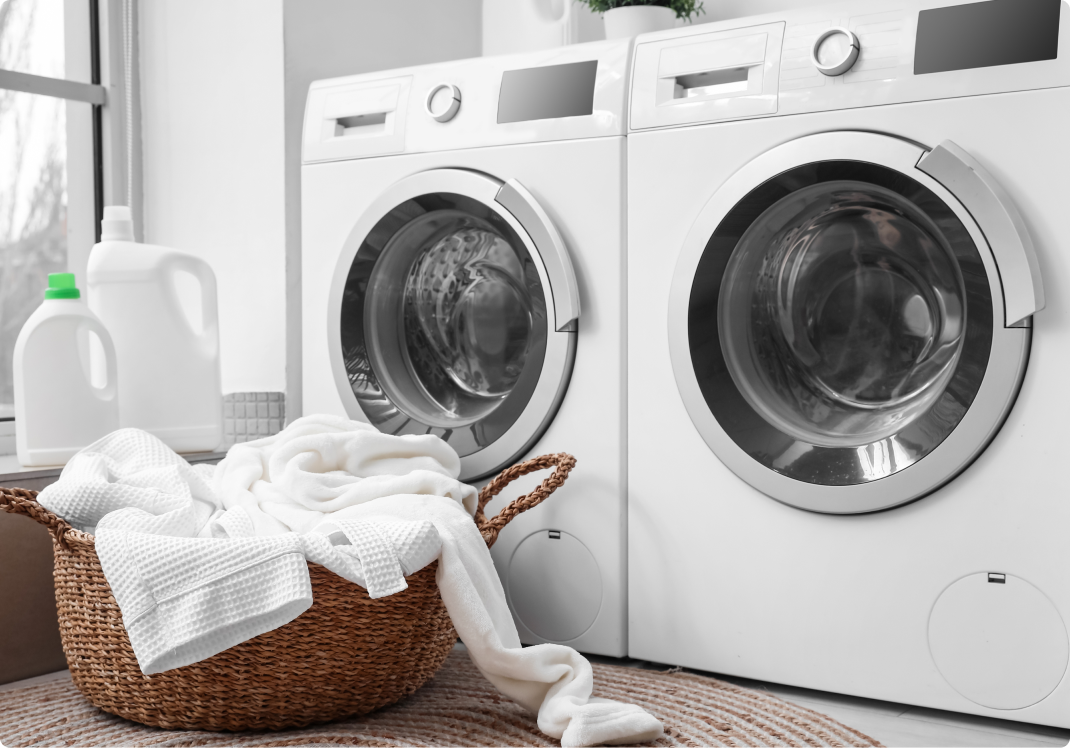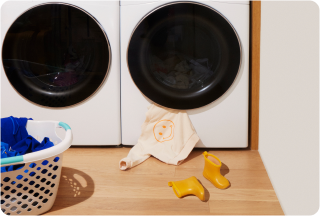Tips for Proper Washer and Dryer Maintenance

We all have to do laundry. Learn how to care for your washer and dryer so they last and work properly. Check out these maintenance tips from American Home Shield®.
There they stand, those faithful servants, our washer and dryer, waiting stoically for their next use. They’re sturdily built, simple to use and only moderately expensive. And if you know how to maintain your washer and dryer, they’ll give you years of service. Let’s explore some practical washer and dryer tips that will extend the lifetime of your appliances and minimize washer and dryer repair costs.
Home washers come in two basic models: front loaders and top loaders. Though initially more expensive, front loaders tend to pay for themselves, as they use about two thirds less water than the less expensive top loaders. Whatever your model, the following automatic washer maintenance tips can help prolong its life.
This is one of the easiest— and most essential— washing machine maintenance steps to perform. Left in the washer, wet clothes create unpleasant odors and can cause mold and mildew buildup if they sit for too long.
Another simple tip is to check the front loader door gaskets for moisture. When wetness is present, it can cause mold and mildew to accumulate, which can prevent the door from sealing properly during the wash cycle. Wipe the gaskets dry after every use and leave the door open slightly, so air can circulate and dry remaining moisture.
While you’re at it, clean the gaskets and drum every month with a solution of equal parts water and vinegar. And for a top loader, leave the door open after each washing to foster air circulation and prevent mildew.
Oversized loads can lead to poor wash results, damaged clothing and damage to the washer as a result of the machine being off balance. For most fabrics, the machine should be loosely filled rather than packed tight.
Two to three times a year, run the washer without any clothes in the drum. Run on the hottest cycle using the normal amount of detergent. These regular washing machine maintenance washes will keep the machine and drain pipes clean and free from dirt, grease and hard-water salts buildup.
Check to make sure the machine is level so the drum is balanced when it spins. Spinning out of balance places a strain on parts and can significantly reduce the longevity of your washer. Most washers use adjustable legs with locking nuts for leveling. (Note: Turn the legs clockwise to lower them and counter-clockwise to raise them.) Adjust and tighten these legs to balance the machine. Some machines also have back legs that adjust automatically. Once you’ve adjusted the front legs, tilt the machine forward to allow the back legs to balance out.
Unattended, a burst water hose can spill hundreds of gallons an hour into your home. To prevent this calamity, inspect your hoses several times a year. If you see cracks or breaks, unplug the machine, turn off the water supply on both hoses and replace them, preferably with braided, metal hoses that can’t split open.
Also, use a bristle brush to clean the filters of debris and sediment that reduce the machine’s water flow. Finally, replace your hoses every five years and tape the date on them so you know when you last replaced them.
To prevent rusting, fill in scratches and gashes with touch-up paint from your local hardware or home supply store. Use a mild soap to wash the outside surfaces as well as the buttons and control dials to prevent sticking and malfunctions. That goes for your dryer, too.
By all means, don’t neglect that trusty dryer standing there by the washer. It’s a bit less complicated than your washer, but it, too, needs preventive dryer maintenance to run smoothly.
Learn how a protection plan can help keep your clothes washer spinning smoothly.

Lint can be lethal for you and your dryer. A dryer can erupt in flames if lint builds up in either the lint screen or the ducts. According to the U.S. Fire Administration, an estimated 2,900 residential fires are caused by dryers annually in the United States. These fires lead to civilian deaths, injuries, and millions of dollars in direct property damage.
After every load, remove and clean the lint screen and use a long brush or hand vacuum to remove any globs of lint at the bottom of the trap. Shine a flashlight into the trap to make sure it’s clear. Taking steps to avoid a home fire is one of the most important pieces of regular dryer maintenance.
At least once a year, clean your dryer’s entire venting system, from the dryer to the outside. If the duct is plastic or ribbed metal, toss it and replace with smooth metal. And make sure the outside vent is free of obstructions. If this task seems a bit beyond your DIY capabilities, hire a professional.
To keep the interior of the dryer clean and the machine running efficiently, don’t put anything soiled into the dryer. If you want to put clothes or towels that are wet for some other reason— a day at the pool or beach, perhaps— run them through your washer first.
This is just as good a dryer tip as a washer one. You may think you can cram your dryer with more than one load and save time, but the opposite is true. Your clothes need the circulation of hot air to dry, and overstuffing impedes this circulation and increases the drying time. Plus, overloading the dryer can cause it to break down.
Though dryer sheets are cheaper, they leave residue in the dryer that can clog vents and reduce dryer efficiency. Liquid fabric softener, used during the washing cycle, is better for your dryer.
Like your washer, the dryer needs to be balanced for maximum performance and longevity. Use the adjustable leveling legs to even out the machine. If your dryer doesn’t have these, use uniformed-sized wood pieces to level it.
Basic washer and dryer maintenance isn’t all that difficult. No matter your level of appliance care expertise, you can save yourself some stress and money by following these simple steps for washer and dryer upkeep. Be good to them, and they’ll be good to you for years to come.
While a little DIY washer and dryer maintenance can go a long way in keeping your appliances in top shape, there are some issues that just need a professional’s touch. Here are a few signs it’s time to call in the experts:
You depend on your laundry appliances to keep your life moving smoothly. So when breakdowns happen, life (and your laundry routine!) can suddenly grind to a halt. With an American Home Shield® home warranty, you can rest easy knowing that your washer and dryer are covered.
With comprehensive coverage that extends to up to 23 of your most essential home systems and appliances, American Home Shield is in your corner for all the breakdowns. Take a load off with American Home Shield, so you can get right back to putting another load (of laundry) in! Compare plans and get a customized home warranty quote today.
AHS assumes no responsibility, and specifically disclaims all liability, for your use of any and all information contained herein.
Have a plan for your home when things don't go according to plan
Shop Home Warranties